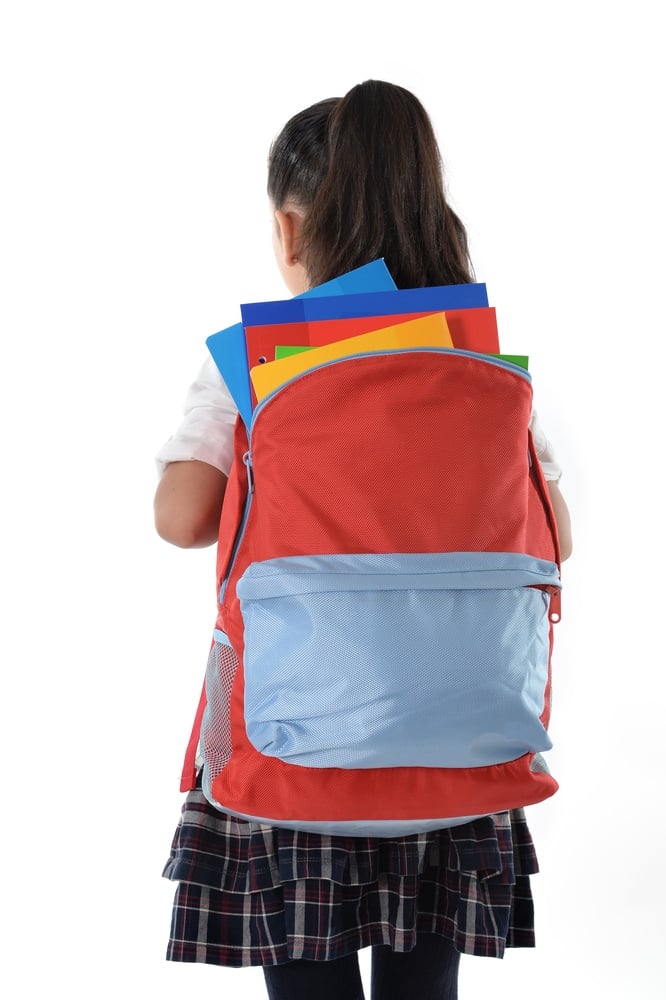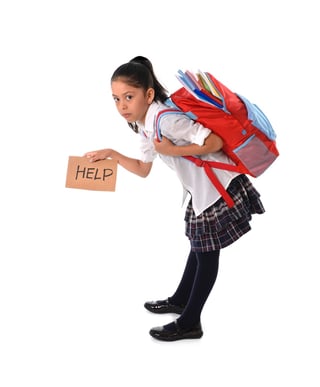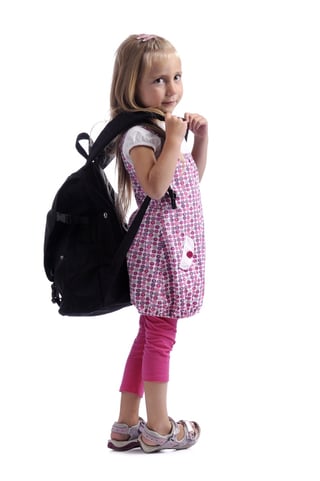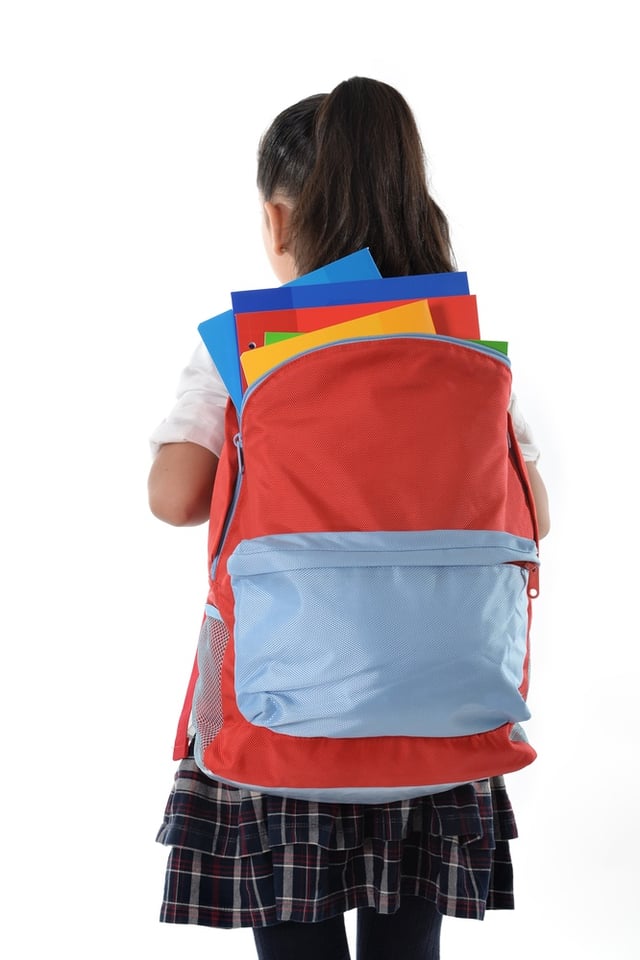Backpacks and back pain in children and school
September 5th, 2016 | 4 min. read


School is starting up again throughout Texas and the rest of the nation. For U.S. school kids, this means a return to carrying heavy backpacks — and the sore backs and posture problems that result.
 Every fall, pain from heavy backpacks is among the most frequent juvenile injuries brought to orthopedists. (Almost as frequent as high school sports injuries.)
Every fall, pain from heavy backpacks is among the most frequent juvenile injuries brought to orthopedists. (Almost as frequent as high school sports injuries.)
If you're a parent of a school-age kid, you may be asking yourself: is wearing a backpack bad for my child?
Not necessarily.
backpacks for school kids: pros and cons
Backpacks are popular for a reason; they leave the hands free and they delegate the "heavy lifting" of textbooks, homework, accessories, and bagged lunches to the strongest part of the body — the back and the abdominal muscles.
Most of the time, backpacks are the most efficient and safest way for children and teens to carry what they need for school.
The case for backpacks ("pros"):
- Backpacks leave the hands free to:
- hold railings; for example, when climbing bus steps
- carry other items like house keys, a musical instrument, or a mobile phone
- maintain balance when walking or running
- hold railings; for example, when climbing bus steps
- Backpacks distribute weight evenly. A properly fitted and packed knapsack is far easier on the back, shoulders, and neck than other types of bags that might swing around too much or create unbalanced posture by pulling on a single shoulder or arm.
- Unlike rolling bags on wheels, backpacks are portable; they can be carried easily up stairs and across different road and weather conditions.
- Backpacks are stash-able. Most are compact enough to store in lockers or under desks.
Backpacks, by and large, are the best way for most children to carry their things to school.
The case against backpacks ("cons"):
- Some are just too big. Newer styles available in stores can be very long or broad. Poor fit to a child's frame, combined with carrying too much weight, can cause back issues.
- Overloaded packs can cause back, neck, and shoulder pain. They can also throw children off balance, making them more likely to fall and sustain other injuries like fractures or sprains.
Backpacks can be great when used correctly. To avoid back problems, take the time to choose the right pack for your child.
back problems in children
Children who habitually carry heavy or unbalanced backpacks may develop the following conditions:
- Circulation problems/nerve damage. Some backpacks have flimsy, narrow straps that aren't well-padded. These can dig into the shoulders, cutting off circulation to the arms and hands. Children may notice a numbness, tingling, or weakness.
- Compressed vertebrae and inflamed cartilage. You've probably seen a child with a heavy backpack get pulled backwards by the weight. Some children try to re-balance themselves by arching their backs or leaning forward at the hips. Either of these motions can compress the vertebrae of the spine, leading to inflammation of the cartilage discs between the bones. This causes soreness in the middle of the back or lower back.
- Muscle contractions. Excessive strain on the back can lead to involuntary flexing and releasing of the muscles, similar to a spasm.
- Neck, upper back, or shoulder strains. A heavy weight pulling on the shoulders can strain (cause tiny tears in) the muscles of the shoulder, neck, and upper back. Strains of the upper back between the shoulder blades are very common, since many children will hump their backs under the weight of the pack.

- Posture issues. Poor posture can result from carrying a poorly-designed, ill-fitting, overloaded bag. Weeks or months of struggling under a heavy weight can lead to problems like rounded shoulders, especially in girls.
- Wearing a backpack on one shoulder, which some children find more stylish, can also contribute to upper back pain by creating an imbalance in posture as the child leans to the other side to compensate.
- In worst-case scenarios, heavy packs may contribute to or worsen scoliosis (curvature of the spine, more common in girls).
- Wearing a backpack on one shoulder, which some children find more stylish, can also contribute to upper back pain by creating an imbalance in posture as the child leans to the other side to compensate.
- Stress fractures. Heavy packs can cause children to lean too far back. This unnatural spinal position creates cracks in the vertebrae (spondylosis). Symptoms of stress fractures include a radiating pain in the buttock and legs.
backpack safety tips for children
Here are 10 tips for parents and children to help avoid back pain:
- Buy the smallest pack necessary. If the pack is too large, your child may be tempted to fill it to capacity.
- Watch the weight. A backpack, when fully packed, should weigh no more than 10–15% of the child's body weight. For example, if your child is 60 pounds, her backpack weight should not exceed nine pounds. A six-pound pack would be even safer. Starting with a lightweight pack made from canvas or nylon is a good start.
- Padded straps and back are a must. Wide, well-cushioned shoulder straps will keep straps from digging into the shoulders. A padded back provides additional comfort and protects the back from being poked by book corners and other objects.
- Look for waist belts. Backpacks with waist belts can help to distribute the weight over the hips, taking some of the pressure off the shoulders and upper/mid back. (The same principle is used in backpacking to help adults comfortably carry gear up to 40+ pounds.)
- Compartments are key. Packs with compartments can help to immobilize objects and distribute weight evenly across the pack. Put heavier items in the center of the pack.

Example of a poor backpack fit: the bag is too large, it's overstuffed, and it's hanging too low on her frame. - Tighten up the straps. Keeping the pack close to the back and centered relieves pressure on the shoulders and lower back. Tighten straps until the pack is worn close. If the bottom of the bag is hanging over the buttocks, the adjustable straps need to be tightened until the bag is brought up.
- Use the locker or cubby. If your child has been assigned a place to keep his things during the day, encourage him to use it instead of carrying every book all day.
- Don't carry everything every day. Look for ways to pack wisely and limit unnecessary items. For example, does your child need to bring every notebook to class every day? Only carry home the books needed to do that night's homework.
- Lift the bag safely. Always bend at the knees to pick up a heavy pack, and use both hands.
- Wear the pack over both shoulders. "One-shouldering" a backpack is unwise and will eventually lead to pain.
If your child has backpack-related back pain that isn't remedied with rest, NSAIDs (aspirin, ibuprofen, naproxen), and lightening up the load, she may need to see an orthopedist for an exam. Give Coastal Orthopedics located in Corpus Christi, TX a call. Telephone: 361.994.1166.
Article written by: Rob Williams, MD
Dr. Williams has been practicing orthopedic surgery in Corpus Christi since 1998. After graduating from Texas Tech hereceived his medical degree from the University of Texas at San Antonio. At the prestigious Campbell Clinic located at the University of Tennessee, Dr. Williams completed not only an Orthopedic Surgery Residency, but an additional year of Fellowship Training in Spine Surgery. Dr. Williams is dedicated to creating an excellent patient experience in the office or in the surgery suite.
Topics:

